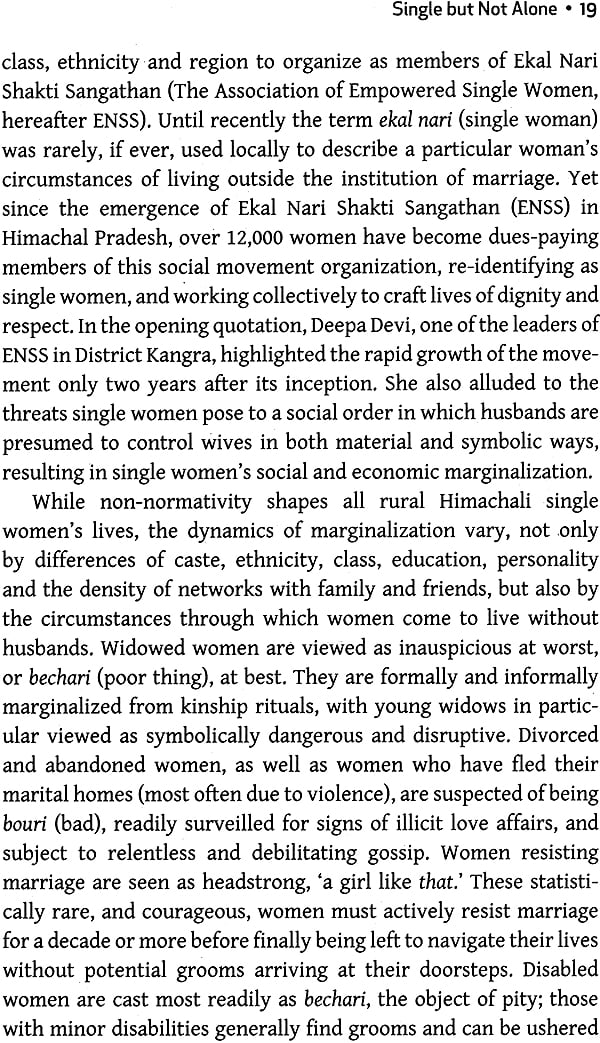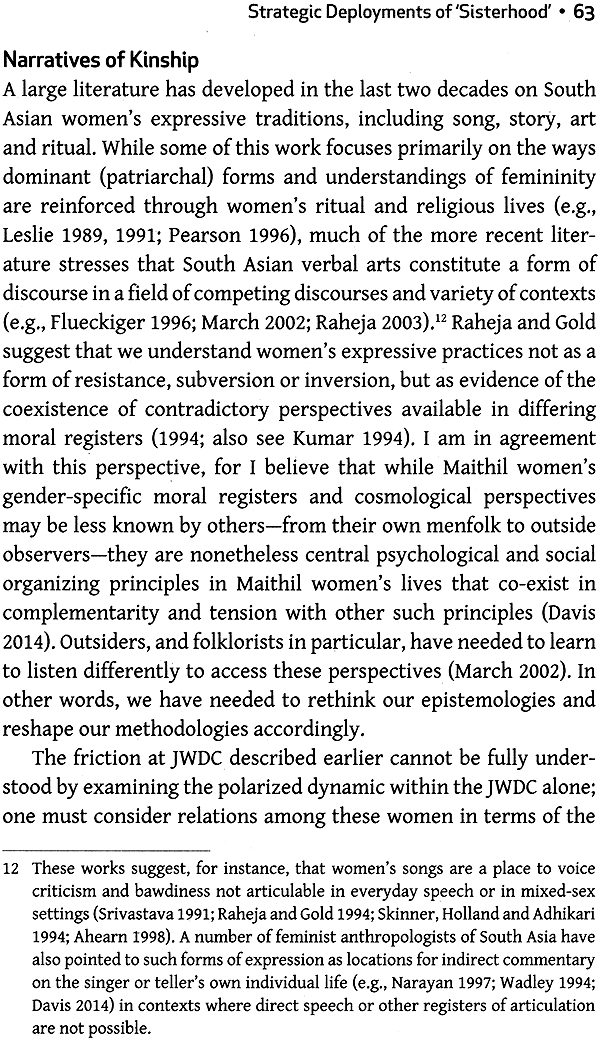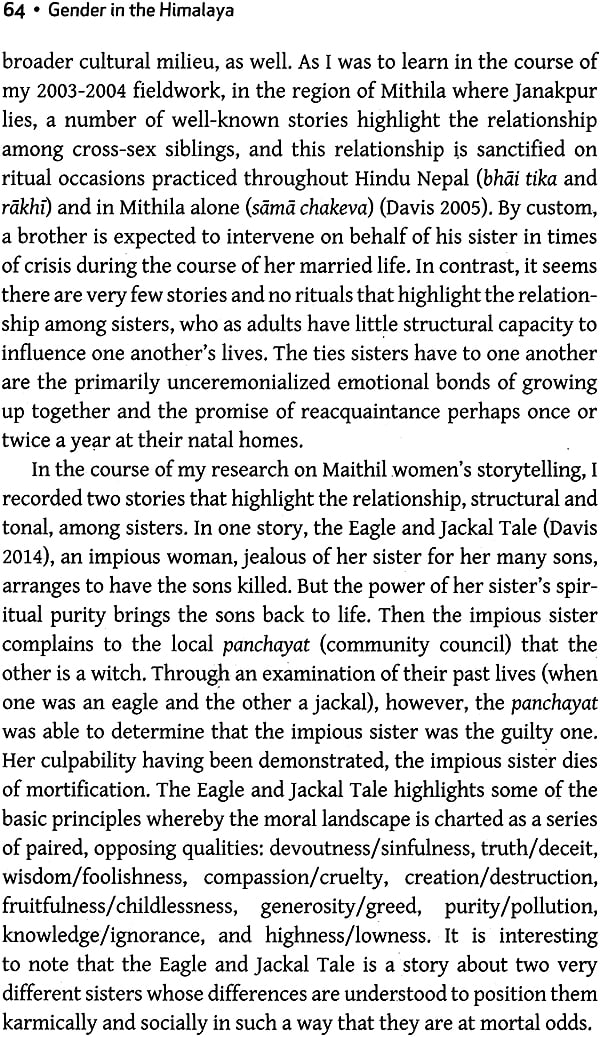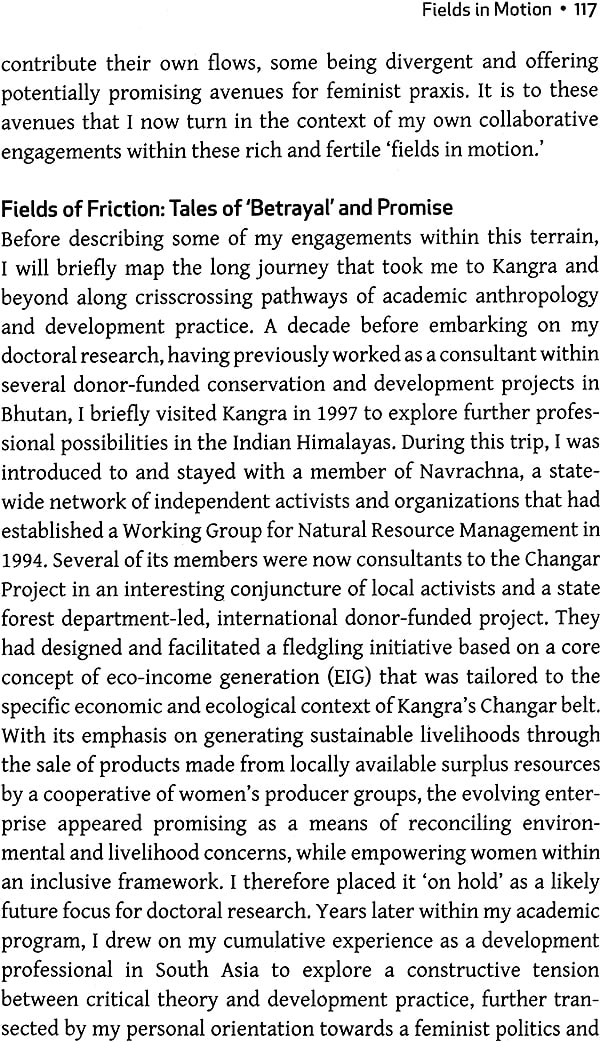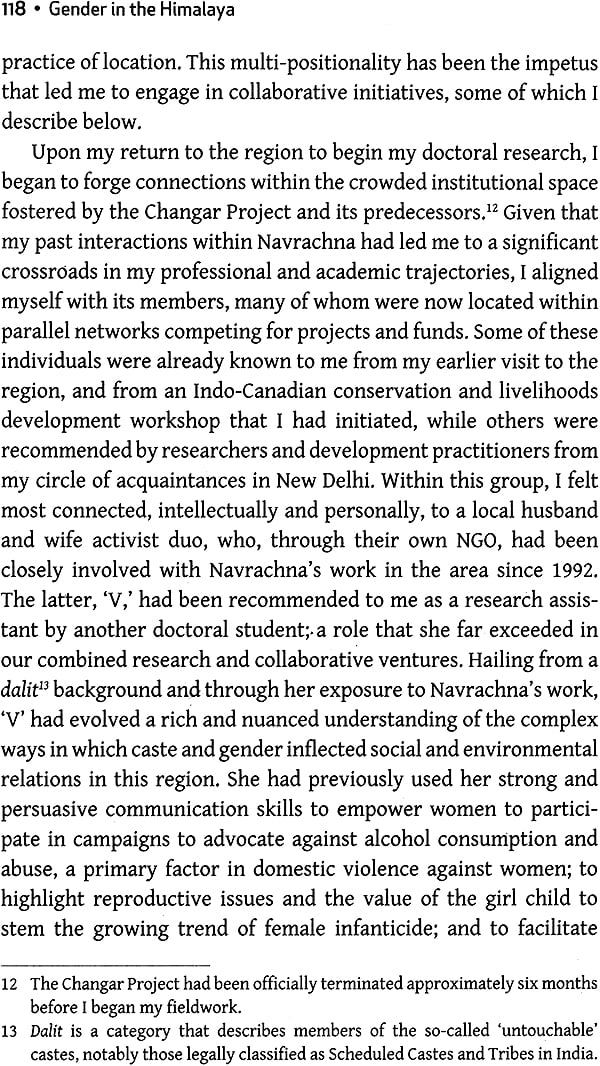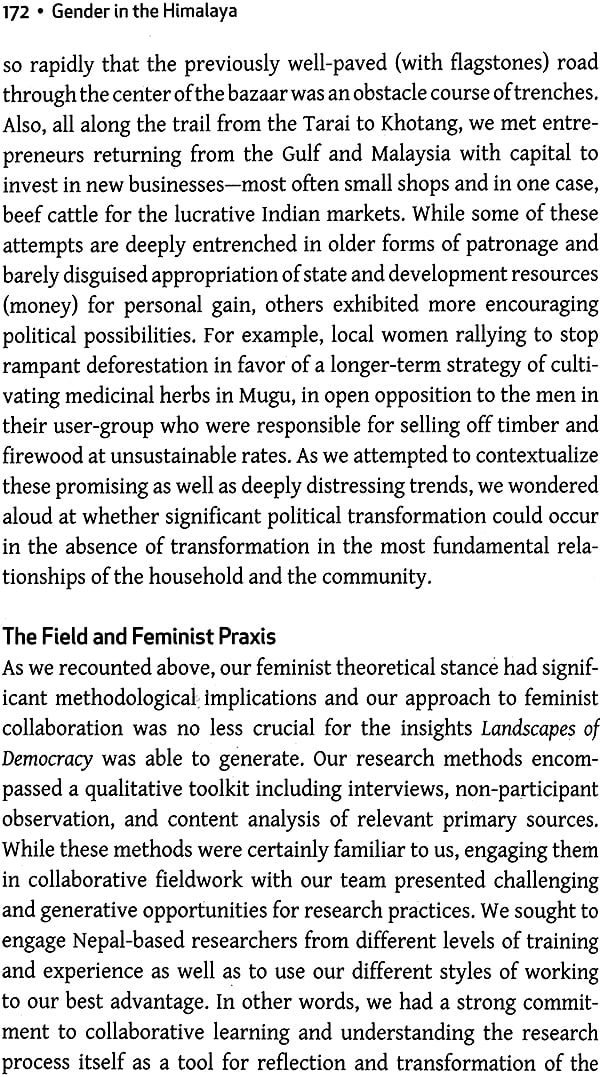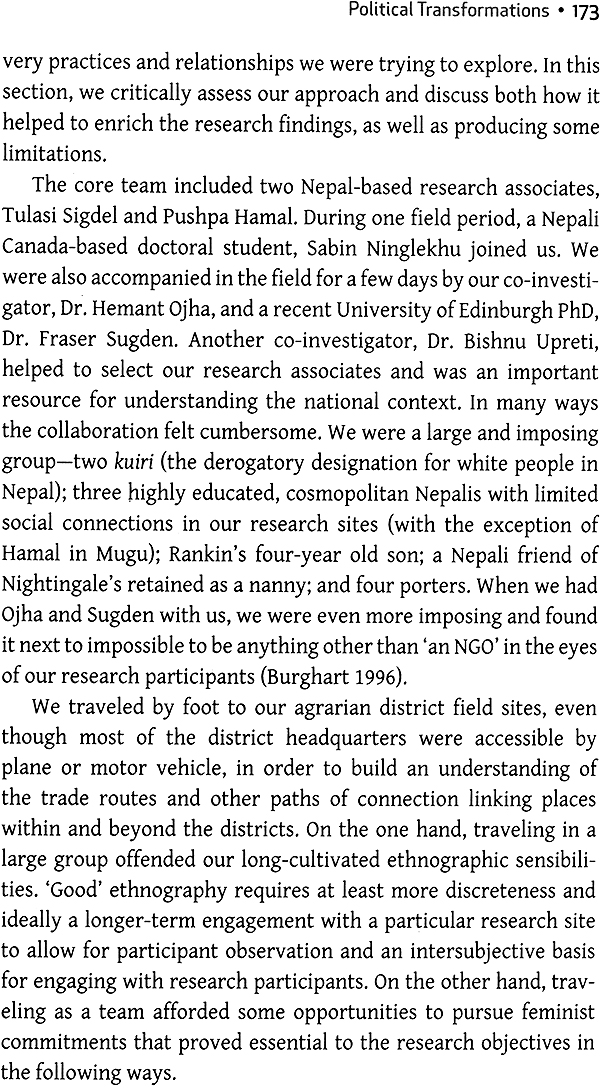
Gender in The Himalaya (Feminist Explorations of Identity, Place and Positionality)
Book Specification
| Item Code: | NAM666 |
| Author: | Shubhra Gururani and Kim Berry |
| Publisher: | Himal Books, Nepal |
| Language: | English |
| Edition: | 2015 |
| ISBN: | 9789937597227 |
| Pages: | 188 |
| Cover: | Paperback |
| Other Details | 8.0 inch x 5.5 inch |
| Weight | 240 gm |
Book Description
Gender in the Himalaya: Cultural Politics of Gendered Identity, Place and Positionality engages with the vibrant field of feminist scholarship and brings together a collection of papers by scholars who have long- term research relations with communities in the Himalayan region. In considering the Himalaya as a frontier that is constituted by a range of context- specific forces as well as historically and politically positioned actors, the papers engage with the Himalayan region but are at once attentive to trans-local forces that configure gendered relations of work, mobility, mobilization, development and activism. Through a critical reading of colonial and nationalist gendered discourses, the contributors demonstrate how gendered relations and subjects are configured through the project of development, feminism, regional autonomy, and neo-liberalism more broadly. By drawing on their sustained engagement with specific field sites and participated with various local and non-local interlocutors, the collections offers a grounded assessment of the ways that feminist readings of everyday practices can illuminate cultural politics of difference, inequality and exclusion. Of additional concern to several of the authors are the politics of knowledge production, including the ethics of transnational feminist scholarship and the politics of positionality in research and representation.
Kim Berry earned her PhD in Anthropology from Cornell University in 1997; currently she is Professor and Chair of Critical Race, Gender and Sexuality Studies at Humboldt State University in northern California. Since 1992, She has conducted research in Kangra District of Himachal Pradesh, India, where she has focused on rural women’s movements for social transformation. Her research, teaching, and activist interests include transnational and intersectional feminism; postcolonial queer theory; theories of space, place and identity; the gendered and recialized effort of neoliberal globalization; and the ethics of transnational feminist research.
Shubhra Gururani is Associate Professor of Social Anthropology at York University, Canada. Her research lies at the intersection of critical political ecology, feminist geography, and science and technology studies. In her work, through ethnography, she explores the everyday practices of gender, place, and nature as they co-constitute each other. She has conducted ethnographic research on the politics of conservation and social movements in the Kumaon Himalayas and her essays have appeared in the Journal of Peasant Studies, International Journal of Social Science, Gender, Place and Culture. She recently co-edited a Special Issue of Conservation and Society and has been researching the politics of urban transformation with a focus on Gurgaon.
Himalayan Feminisms: A Brief Overview
It is generative to think of the Himalayas as a frontier. Consider the region's long history of trans-local connections through trade networks, labor migration, and episodes of conquest and resistance. According to Anna Tsing, a frontier is not a place, project, indigenous category, but rather an enactment of "nonlinear leaps and skirmishes that come together to create their own intensification and proliferation" (2005: 33). It is a shifting terrain constituted by local and trans-local forces and actors that shape everyday practices. This framework allows us to examine the multi-scalar dimensions of regional modernity, as well as to examine the gendered relations and subjectivities that are constitutive of the cultural politics that make and remake the Himalayas.
Since the eighties, and especially with the worldwide popularity of social movements such as Chipko which included a prominent presence of women, there has been an effort to engage the question of gender and gendered livelihoods in the Himalayas. In a critical response to essentialist and functionalist readings of women's participation in environmental campaigns, development projects, and social movements, a rich body of work has emerged over the last two decades that attends to the complex ways gender operates at the intersection of material and symbolic realms (see Shiva 1988). This literature has increasingly drawn attention to the ways gender intersects with ethnicity, kin position, caste, religion, age, and other salient markers of difference within locales (see Uttara 1994; Mawdsley 2000; Gururani 2000, 2002; Chatterjee 2001; Rankin 2001, 2003; Berry 2003; Klenk 2004; Nightingale 2011). Especially, with critical analyses of development projects and discourses that have shaped the social geography of the Himalayas since the mid-twentieth century, several authors have engaged with the cultural politics of development, empowerment, and participation from a gendered perspective (see Pigg 1992; Rankin 2001, 2003; Berry 2003; Ahearn 2004; Klenk 2004; Leve 2007).
Along with critical evaluation of development, a rich and growing body of work has engaged with the political economy and colonial history of environmental politics. In the emerging field of feminist political ecology, many feminist scholars have focused on forests and forestry and contributed a gendered perspective to discussions of ecological knowledge, subject formation, access to resources, livelihoods, and governmentality (see Agarwal 1994; Rangan 1996; Nightingale 2006; Gururani 2000, 2002; Linkenbach 2007). In the domains of water and irrigation too, several contributions have taken seriously the intersections of caste, gender, and class in resource politics (Baker 2007). Much of this work analyzes a politics of gendered exclusion that has resulted from the overlay of development discourses on state-led resource management endeavors (see Adhikari 2001; Lama and Buchy 2002; Buchy and Subba 2003). An equally important body of scholarship has attended to the colonial and postcolonial politics of gendered labour relations as they have played out on tea-plantations (Chatterjee 2001; Besky 2008). More recently, in light of the political upheaval and massive transformations in Nepal, several scholarly interventions have analyzed political change through gendered lenses (see Gautam et al 2001; Tamang 2002; Shneiderman 2003, 2009; Pettigrew and Shniederman 2004; Aguirre and Pietro paoli 2008; Nightingale 2015).
Furthermore, some of the most reflective works on feminist methodology and the politics of positionality have emerged from work on Himalayan women's songs, stories and life histories. For example, Narayan and Sood (1997), partnering on folktales within the foothills of the Indian Himalayas, and March (2002), working within the Nepal Himalayas, reflect on the politics of knowledge 'production within structured inequalities (also see Ahearn 2001, 2004). This work embraces the possibilities (and not simply the limitations) of partial perspectives, ultimately claiming space for the significance of dialogue across differences. Their work thus demonstrates the possibilities of understanding, empathy, and long-lasting relationships that are meaningful but also simultaneously asymmetrical, revealing both "shared humanity" as well as "unexpected differences" (March 2002: 2).
Narayan and Sood's and March's critical reflections on methodology are part of the prominent feminist interventions in the last few decades of social science scholarship which attend to the positionality of the researcher in shaping the contours of knowledge. Emerging from intense debates and discussions among feminist scholars in the eighties and nineties, there has been a shift in feminist scholarship to pay special attention to the practice of research and the politics of knowledge-making. This line of inquiry and critique has been particularly influential in the disciplines of anthropology and cultural geography in which feminists such as Abu-Lughod (1990), Chatterjee (2001), Gold and Raheja (1994), Hanson and Pratt (1995), Kobayashi (1994), Massey (1994), McDowell (1992, 1999), Nagar (2002), Narayan (1993), Strathern (1987), Visweswaran (1994), and Wolf (1990) among others have not only interrogated established research methodologies but also put forth frameworks for feminist research and ethnography. By drawing attention to the explicit and implicit inequalities of power between the researcher and the researched, feminist ethnographers have advocated for collaborative, participatory, and dialogic research processes that acknowledge and negotiate the power differential.
In drawing from this influential body of feminist work in the Himalayas, the scholars whose work is highlighted in this special issue reflect on their own research and further the discussion on gendered subjectivities, political mobilization, and activism. Below we discuss the articles in the context of three interconnected themes: development as discourses, practices, and imaginative spaces; the co-constitution of gendered subjectivities and new spaces for political mobilization; and feminist methodologies.
Development Imaginaries
All of the articles in this special issue relate to development, not only as sets of practices and institutions, but also as sites of imagination and discursive terrain. In her article on the Janakpur Women's Development Center UWDC) in Kathmandu, Coralynn Davis charts the history of discourses shaping 'women's development' over the decades: from a focus on women's domestic roles as mothers and wives, to the integration of women into 'mainstream' development programs, and finally to 'women's empowerment,' the latter concept being over-determined by neoliberal logics of income generation and entrepreneurship. Davis also highlights a discursive focus on cultural preservation within Nepal, particularly of Newar architecture in Kathmandu Valley, as integral to projects of promoting tourism. About the JWDC she writes, "It is no wonder, then, that a project bent on empowering women, generating income through tourist market activity and preserving cultural material and practice excited the imaginations of primary and secondary development aid institutions, not to mention inter- national tourists."
Davis's primary focus is the contested meaning of sisterhood as it operates within the space of the JWDC. While within western discourses of feminism, sisterhood has been a prime signifier of solidarity among women (often minimizing or negating differences through romanticized use of this term), Davis argues that 'sister' for Maithil women more readily signifies separation, hierarchy, and jealousy. Drawing on cultural meanings of sisterly relations rooted in kinship practices, language, storytelling, and everyday speech acts, Davis explores JWDC workers' strategic use of the multiple meanings and registers of a variety of words for 'sister' to negotiate hierarchical differences and conflict of interest: between foreign tourists who purchased the paintings and the crafts women who produced them; between women workers and managers of different communities, ages and levels of formal education and literacy; between Nepali women and the us women they closely engaged with-both the founding director of JWDC and Davis herself. Davis argues that, "For the women producers at JWDC, using the term 'sister' provides access to a world of status and privileged connection that is part of the very stuff of development, locally articulated." The same signifiers are used by local women to negotiate ambiguous relations of trust, dependency, intimacy, hierarchy, and difference in such a way that their tactical movements and subtle critique do not put at risk those important social ties.
Similarly calling attention to the concept of development as a meaning making practice, Radhika johari refers to 'developmentalizing' as "an active and open-ended process of becoming" to high-light "competing imaginaries that shape and texture varied forms of practice." She interrogates development flows within District Kangra of Himachal Pradesh (India), attending to the transnational discourses and histories of project funding which emerge out of and give shape to development imaginaries: cold war anti-communism; national sovereignty through food security; watershed management and livelihood strategies to promote environmental and social well-being; and women's empowerment. Tracing the history of the Changar project in District Kangra, funded through a bilateral agreement between the German Agency for Technical Cooperation and the state government of Himachal Pradesh, Johari argues that local activists and groups interact with transnational imaginaries, contributing to the flow of meanings and shaping institutional spaces and practices. Ultimately, she states: "'developmentalizing' is an inherently creative process that generates a multiplicity of forms, perspectives and approaches; some of which offer potential for social and political empowerment at the grassroots."
While other authors in this special issue do not focus on development as a primary theme, it reverberates throughout each article. Katharine Rankin and Andrea Nightingale highlight the relationship between imaginaries of development and political mobilization. In an analysis of the political transition in Nepal, they interrogate one of the key tropes of contemporary development discourse, what they refer to as the "desire called civil society." They simultaneously critique the absence of attention to economic inequalities underlying this faith in the trans formative power of civil society while also highlighting the hegemonic forms of inequality within this arena. They argue that studies on political transition in Nepal must "move beyond the prevailing preoccupation with inclusion of named marginalized groups in formal modes of political representation. Instead, more attention must be paid to the ways in which social inequality and injustice is institutionalized in everyday life." They further argue that the household is a key site for the analysis of the reproduction and normalization of inequalities, and that radical projects of political transformation will have to interrogate entrenched inequalities within the house- hold as well as beyond it.
Shubhra Gururani similarly explores the political mobilization and re-imagining of place in her analysis of the successful struggle for the establishment of the autonomous hill state of Uttarakhand in northern India. She refuses the dominant narrative of uttarakhand as a 'remote' place and instead argues that it "came to be constituted at the nexus of global capitalism, imperialism, colonialism, and developmentalism." Gururani traces the gendered histories of labor, forests, and liquor in this region, framing landscape as dynamic and co-constituting space, place and identity. In this nuanced discussion of emplaced identities, she argues that the continued marginalization of the uttarakhand region under the state of Uttar Pradesh led to demands for separate statehood. Central to this complex and contradictory movement (sparked as it was by opposition to reservation of government jobs for members of OBCs, or other backward castes) was a discourse of regional disparities and demands for progress, both of which were embedded firmly in the tropes of 'development' and modernity.
Rebecca Klenk, also writing about Uttarakhand, analyzes the life of Sarala Devi and her establishment of Lakshmi Ashram in the Kumaon Hills. In this nuanced reading of the life of an exceptional Himalayan woman, Klenk provides us with a transnational story of the creation of this Gandhian institution of and for development alongside a narrative of an individual's struggles to craft her identity. Klenk traces the possibilities, contradictions and limitations of British born Sarala Devi's twenty years of work, following in the footsteps of Gandhi, and forwarding a curriculum to craft Indian subjects capable of realizing a vision of village self-sufficiency and simplicity.
| 1 | Introduction | 1 |
| 2 | Single but Not Alone: The Journey from Stigma to Collective Identity through Himachal's Single Women's Movement | 18 |
| 3 | Strategic Deployments of 'Sisterhood' and Questions of Solidarity at a Women's Development Project in janakpur, Nepal | 47 |
| 4 | "Geographies that Make Resistance": Remapping the Politics of Gender and place in Uttarakhand, India | 74 |
| 5 | Fields in Motion, Fields of Friction: Tales of 'Betrayal' and Promise from Kangra District, India | 101 |
| 6 | Gandhi's Other Daughter: Sarala Devi and Lakshmi Ashram | 133 |
| 7 | Political Transformations: Collaborative Feminist Scholarship in Nepal | 159 |
| The Contributors | 186 |

